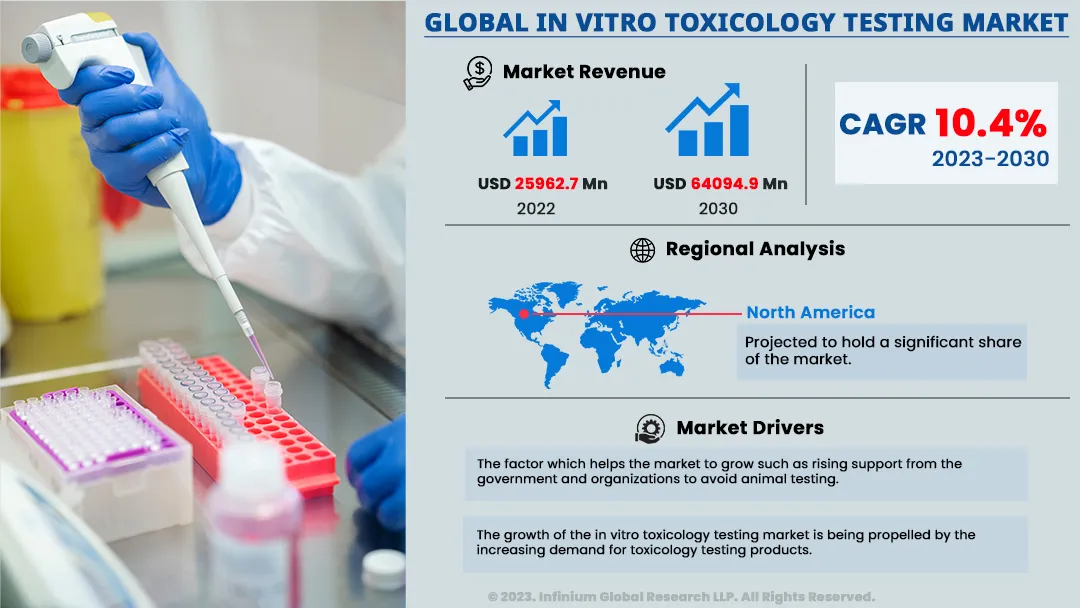In Vitro Toxicology Testing Market (Technology - Cell Culture Technology, High Throughput Technology, Molecular Imaging, and OMICS Technology; Application - Systemic Toxicology, Dermal Toxicity, Endocrine Disruption, Ocular Toxicity, and Others; Method - Cellular Assay, Biochemical Assay, In silico, and Ex-vivo): Global Industry Analysis, Trends, Size, Share and Forecasts to 2030
A recent report published by Infinium Global Research on in vitro toxicology testing market provides in-depth analysis of segments and sub-segments in the global as well as regional in vitro toxicology testing market. The study also highlights the impact of drivers, restraints, and macro indicators on the global and regional in vitro toxicology testing market over the short term as well as long term. The report is a comprehensive presentation of trends, forecast and dollar values of global in vitro toxicology testing market.
Market Insight:
The study of a substance's harmful effects on cells, tissues, or organs removed from a living organism is known as In vitro toxicology testing. Tests are performed in a controlled laboratory setting using a variety of cell-based assays or tissue cultures to assess a substance's potential toxicity. Compared to conventional in vivo (whole animal) testing techniques, in-vitro toxicology testing methods have a number of benefits. They are often more ethical, quicker, and less expensive. Additionally, they can be used to evaluate a greater variety of compounds and look into particular toxicity processes. In-vitro toxicology testing's main objective is to determine and assess the harmful effects such as chemicals, medications, cosmetics, and other substances have on human health. This kind of testing offers important insights into the security and potential dangers connected to exposure to these substances.
The factors which help the market to grow such as rising support from government and organizations to avoid animal testing, governments and organizations have provided funding and grants to support research and development in alternative testing methods, to advance the field, improve the capabilities of in vitro testing, and encouraging industries to adopt these methods. Additionally, the growth of the in vitro toxicology testing market is being propelled by the increasing demand for toxicology testing products, Industries across pharmaceuticals, cosmetics, chemicals, and consumer products are actively seeking reliable and efficient testing solutions to ensure the safety of their products. The factor which restrains the growth of the market is a shortage of skilled workers, the lack of skilled professionals is a major restraint for the global in vitro toxicology testing market. This is because in vitro toxicology testing requires a wide range of skills such as Technical skills, Analytical skills, and observational skills. Technological advancements in, in vitro toxicology testing products create opportunities for companies operating in the market. Advancements such as 3D cell culture models, and high-throughput screening. These advancements enable companies to develop and offer cutting-edge products for consumers.

The global in vitro toxicology testing market is segmented into North America, Europe, Asia Pacific, and the Rest of the World (ROW). Among these regions, North America is projected to hold a significant share of the market. This can be attributed to factors such as technological advancements and government support that have accelerated the development of innovative and cost-effective testing methods in North America. The region has witnessed significant investments in research and development, driving the adoption of in vitro toxicology testing for assessing the safety of drugs, devices, chemicals, and cosmetics. On the other hand, the Asia Pacific region is expected to exhibit the highest growth rate in the market. Government incentives for technology and development, along with rising healthcare expenditure, are key drivers of market growth in this region. Government organizations in the Asia Pacific are actively promoting in vitro toxicology testing methods and encouraging their adoption. The increasing focus on safety assessments and the growing demand for reliable testing methods in industries such as pharmaceuticals, cosmetics, and chemicals contribute to the growth of the market in the Asia Pacific region.
Report Scope of the In Vitro Toxicology Testing Market:
| Report Coverage | Details |
|---|---|
| Market Size in 2022 | USD 25962.7 Million |
| Market Size by 2030 | USD 64094.9 Million |
| Growth Rate from 2023 to 2030 | CAGR of 10.4% |
| Largest Market | North America |
| No. of Pages | 255 |
| Market Drivers |
|
| Market Segmentation | By Technology, By Application, and By Method |
| Regional Scope | North America, Europe, Asia Pacific, and RoW |
Segment wise revenue contribution in the global in vitro toxicology testing market
The report on global in vitro toxicology testing market provides a detailed analysis of segments in the market based on Technology, Application, and Method.
Segmentation Based on Technology
· Cell Culture Technology
· High Throughput Technology
· Molecular Imaging
· OMICS Technology
Segmentation Based on Application
· Systemic Toxicology
· Dermal Toxicity
· Endocrine Disruption
· Ocular Toxicity
· Others
Segmentation Based on Method
· Cellular Assay
· Biochemical Assay
· In silico
· Ex-vivo
Company Profiled:
· Charles River Laboratories
· SGS Société Générale de Surveillance SA.
· Thermo Fisher Scientific Inc.
· Eurofins Scientific
· Merck KGaA
· Cyprotex
· Gentronix
· Abbott Laboratories
· Evotec SE
· Agilent Technologies, Inc.
Report Highlights:
The report provides deep insights into demand forecasts, market trends, and micro and macro indicators. In addition, this report provides insights into the factors that are driving and restraining the growth in this market. Moreover, The IGR-Growth Matrix analysis given in the report brings an insight into the investment areas that existing or new market players can consider. The report provides insights into the market using analytical tools such as Porter's five forces analysis and DRO analysis of the in vitro toxicology testing market. Moreover, the study highlights current market trends and provides forecasts from 2023-2030. We also have highlighted future trends in the market that will affect the demand during the forecast period. Moreover, the competitive analysis given in each regional market brings an insight into the market share of the leading players.
